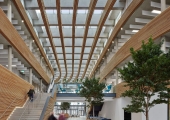April 2, 2014
New consortium aims to standardise technology to drive Internet of Things
 The development of the much talked-about Internet of Things has been boosted with the announcement that AT&T, Cisco, GE, IBM and Intel have come together to form a group called the Industrial Internet Consortium (IIC) which will aim to standardise the way certain technologies function and so drive the uptake of the Internet of Things. The group has the apparent backing of the White House which has also announced that it will invest $100 million in research into the way physical objects can be linked to the internet, which is the fundamental principle of the Internet of Things. The IIC will be outlining its own plans in the near future to establish a common, global framework for the development of inter-connected digital and physical worlds and so sped up the adoption of an idea that promises to transform many aspects of our lives but which has not moved quickly enough, according to many commentators.
The development of the much talked-about Internet of Things has been boosted with the announcement that AT&T, Cisco, GE, IBM and Intel have come together to form a group called the Industrial Internet Consortium (IIC) which will aim to standardise the way certain technologies function and so drive the uptake of the Internet of Things. The group has the apparent backing of the White House which has also announced that it will invest $100 million in research into the way physical objects can be linked to the internet, which is the fundamental principle of the Internet of Things. The IIC will be outlining its own plans in the near future to establish a common, global framework for the development of inter-connected digital and physical worlds and so sped up the adoption of an idea that promises to transform many aspects of our lives but which has not moved quickly enough, according to many commentators.
























February 24, 2014
HS2 is a project for today projected into an uncertain future
by Mark Eltringham • Comment, Facilities management, Flexible working, Technology
Barely a day passes in the media without some new battleground opening up in the debate about the UK’s plan to develop HS2, the high speed line connecting London with Birmingham, Leeds, Manchester, Sheffield and, for some reason, a place nobody’s heard of halfway between Derby and Nottingham called Toton (pop. 7,298). While the debate rages about the cost, the economic benefits, regional rebalancing, environmental impact, route and why the Scots and others are paying for a project that may leave them with worse train services, one of the fundamental flaws with the case for HS2 goes largely disregarded. It is that this is clearly a project designed for today, but that won’t be complete for another twenty years. The world then will be very different and, unfortunately, time isn’t quite as malleable as the movies would have us believe.
More →